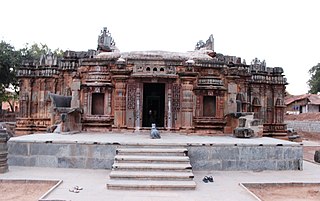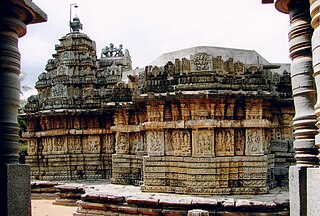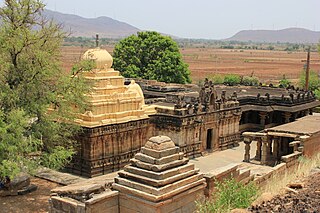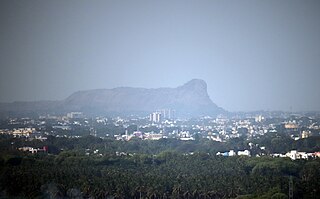
The Someshwara temple, situated in Kolar town of Karnataka state, India is an ornate 14th century Vijayanagara era Dravidian style construction. Someshwara, another name for the Hindu god Shiva is the presiding deity in the temple. The temple is protected by the Archaeological Survey of India as a monument of national importance.

Lakshmi Narasimha Temple, also referred to as Lakshminarasimha temple of Bhadravati, is a 13th-century Hindu temple dedicated to Vishnu, built by the Hoysala ruler Vira Someshwara. It is located in Bhadravati, Shimoga District of Karnataka state, India. The temple opens to the east and has three sanctums, one each dedicated to Venogopala, Lakshminarasimha and Vishnu-Puroshottama. It is notable for its Vesara architecture, with artwork that includes legends and deities of Vaishnavism, as well as those of Shaivism, Shaktism and Vedic deities. Important reliefs include those of Ganesha, Dakshinamurti, Bhairava, Sarasvati, Brahma, Surya, Harihara, and others. The temple's original shikaras were ruined, and have been restored with a conical structure. According to Adam Hardy – a scholar of Indian temple architecture, this temple has two "exceptional" stellate structures highlighting the architectural sophistication of the Hoysalas.

The Veera Narayana temple, also referred to as the Viranarayana temple of Belavadi, is a triple Hindu temple with a complex Hoysala architecture completed around 1200 CE. Close to Halebidu, this is a better preserved large Hoysala monument found in the small village of Belavadi, Chikkamagaluru district of Karnataka, India.

The Ranganathaswamy temple or Sri Ranganathaswamy temple in Srirangapatna, in the Mandya district of Karnataka state, India, is dedicated to the Hindu god Ranganatha. The temple is Classified one among the 108 Abhimana Kshethram of Vaishnavate tradition. It is one of the five important pilgrimage sites of Smartha Vaishnavas and Sri Vaishnavism along the river Kaveri for devotees of Ranganatha. These five sites are collectively known as Pancharanga Kshetrams in South India. Since Srirangapatna is the first temple starting from upstream, the deity is known as Adi Ranga. The town of Srirangapatna, which derives its name from the temple, is located on an island in the river Kaveri.

The Chandramauleshwara Temple, sometimes referred to as the Candramauḷĩśvara or Chandramouleshwara temple at Unkal, is an 11th century Shiva temple with Chalukyan architecture in Unkal (Hubballi), Karnataka, India. TIt is built on a square-cross plan with one entrance for each cardinal direction, corresponding to the sandhara plan found in Sanskrit texts on architecture. It originally had a Chaturmukha (four-faced) Linga in the center of the temple and many more mandapas (halls), but the surviving structure is much smaller.

Belavadi is a village, located at a distance of 29 km from Chikmagalur town and about 12 km from Halebidu, Karnataka, India. The place is described as Ekachakranagara of Mahabharata and the village is known for Veeranarayana temple of Hoysala architecture.

Bucesvara temple, also referred to as the Buceswara, Bucheshwara or Bhucheshvara temple, is a 12th-century Hindu temples in Koravangala village, Karnataka, India. The most sophisticated historical temple in the village, it is considered to be the flag-bearer of Hoysala architecture and was built by a wealthy patron named Buchi during the reign of king Ballala.

The Mallikarjuna temple, dedicated to the Hindu god Shiva, is in Basaralu, a small town in the Mandya district, Karnataka state, India. Basaralu is close to Nagamangala and about 65 km from the culturally important city of Mysore. The temple was built by Harihara Dhannayaka around 1234 A.D. during the rule of the Hoysala Empire King Vira Narasimha II. This temple is protected as a monument of national importance by the Archaeological Survey of India.

The Kalleshvara temple is located in the town of Ambali in Bellary district of Karnataka state, India. According to an Old Kannada inscription placed in the sabhamantapa, the temple was constructed during the reign of the Western Chalukya Empire King Vikramaditya VI. This temple is protected as a monument of national importance by the Archaeological Survey of India.

The Mallikarjuna temple is located in the town of Kuruvatti in the Bellary district of Karnataka state, India. The temple was constructed in the early 12th century rule of the Western Chalukya Empire. The temple is protected as a monument of national importance by the Archaeological Survey of India.

The Lakshminarasimha temple at Javagal, sometimes referred to as Lakshmi Narasimha temple of Javagallu, is a mid-13th century Hindu temple with Hoysala architecture. It is located in Javagal about 20 km northeast from Halebidu and 50 km from Hassan city, Karnataka state, India. This triple shrine temple is dedicated to Narasimha – the man-lion avatar of Vishnu. It was completed between 1250 and 1260 CE by King Vira Someshwara of the Hoysala Empire.

The Kaitabheshvara temple is located in the town of Kubatur, near Anavatti in the Shimoga district of Karnataka state, India. The temple was constructed during the reign of Hoysala King Vinayaditya around 1100 AD. The Hoysala ruling family was during this time a powerful feudatory of the imperial Western Chalukya Empire ruled by King Vikramaditya VI. According to the Archaeological Survey of India, the architectural signature of the temple is mainly "Chalukyan". Art historian Adam Hardy classifies the style involved in the construction of the temple as "Later Chalukya, non mainstream, far end of spectrum". The building material used is soapstone The temple is protected as a monument of national importance by the Archaeological Survey of India.

Kalleshwara temple is located in the village of Bagali it was 9km away from Harpanahalli city in the Vijayanagara district of Karnataka state, India.

Kedareshwara Temple is a Hoysala era construction in the historically important town of Halebidu, in the Hassan district of Karnataka state, India. It is located a short distance away from the famous Hoysaleswara Temple. The temple was constructed by Hoysala King Veera Ballala II and his Queen Ketaladevi, and the main deity is Ishwara. The temple is protected as a monument of national importance by the Archaeological Survey of India.

Yanaimalai is a protected monument and tourist attraction in Tamil Nadu, India. It has Jain sculptures, a Shaivite temple, and a Vaishnavite temple, namely the Narasingam Yoga Narasimha Perumal Temple.

The Lakshminarasimha temple at Vignasante is a 13th-century Vishnu temple in the village of Vignasante, Tumkur district, Karnataka, India. The three-shrine temple is dedicated to Venugopala, Narasimha and Lakshmi Narayana. One of the late temples built before Hoysala empire came under sustained attacks from the Delhi Sultanate, it illustrates the mature Hoysalanadu architectural tradition. The fully carved, three storey Vesara vimana of this temple is notable.

The Shivappa Nayaka Palace named after the popular 17th-century king Shivappa Nayaka of the Keladi Nayaka dynasty is located in Shivamogga city, the district headquarters of the Shivamogga district in Karnataka state, India. It is now the site of the Government Museum.

The Gunja Narasima Swamy Temple is a Hindu temple in Tirumakudal Narasipura, a town in the Mysore district, Karnataka state, India. The town is located 20 miles south east of the historically important city of Mysore. The temple dates back to about the 16th rule of the Vijayanagara empire and is built in typical dravidian style with an imposing gopura (tower) over the entrance gate (mahadwara) and a four pillared mantapa ("hall") in front of the sanctum. The temple is located at the confluence of the Kaveri river and the Kabini river and is considered sacred by Hindus. The temple gets its name from the Gunja(Gulaganji in Kannada) tree that grows in the front of the main entrance; a boastful local claim is that the temple is more sacred than Varanasi (Kashi) by the weight of a gunja plant. Sculptures in the temple include those of the Hindu god Narasimha and the demon King Hiranyakashipu.

Srirangapatna Fort is a historical fort located in Srirangapatna, the historical capital city of the Kingdom of Mysore in present-day South Indian state of Karnataka. Built by the Timmanna Nayaka in 1454, the fort was modified by King Haider Ali & King Tipu Sultan and fully fortified in the late 18th century with the help of French architects. King Tipu Sultan wanted to protect it against British invaders associated with the East India Company.





















